You are here
Home › Research › RTTA 3: Anticipation & Deliberation › RTTA 3/4: Futurescape City Tours › Session IIISession III
Last Updated: July 29, 2013
Planning for Session III:
For Session III to go smoothly participants MUST upload their photos to Flickr (see instructions). In addition, they MUST tag those photos, add them to the correct Flickr stream, and write captions explaining what about the image was significant or what the image tells people about the past, present, or future. We found that it is helpful to provide some guidance, in the form of examples, as to the kinds of photos and style of captions that are useful. This can be provided during Session I, as per the  prompts_for_fct_captions.pptx. Within the broad frames, the participants can express their own vision and thoughts.
prompts_for_fct_captions.pptx. Within the broad frames, the participants can express their own vision and thoughts.
During the deliberative session participants admitted that of the 20 images each chose, they selected out anything that was a negative outcome or observation. They only chose what they described as positive for the final images. This shaped the discussion and activities heavily for Session III since the conversations were based on the images. Given this, it might be important to either 1. Track whether this happens at other sites, the selecting out of the “negative” or 2. Provide deliberate instructions to select “positive” and “negative” representations.
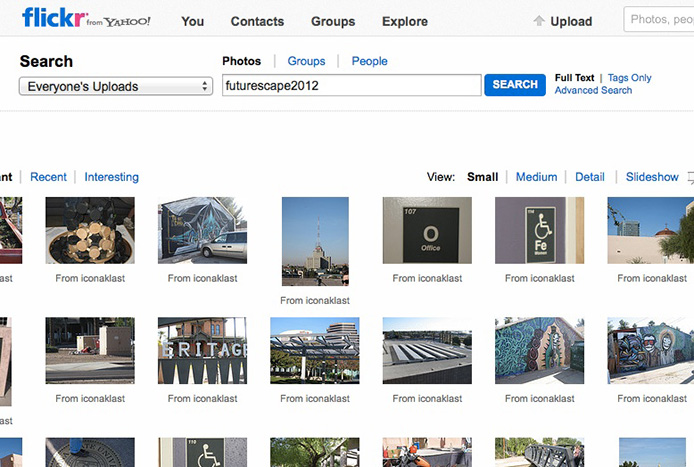 Futurescape 2012 Tagged on Flickr (flickr.jpg)
Futurescape 2012 Tagged on Flickr (flickr.jpg)
In addition to the Flickr instructions we created a “How to get more involved ![]() worksheet.docx” that included names and contact information of any of the organizations or agencies mentioned during the tours as well as others that might be a bit difficult to track down.
worksheet.docx” that included names and contact information of any of the organizations or agencies mentioned during the tours as well as others that might be a bit difficult to track down.
Finally, please remind participants to bring their workbooks to Session III so that you can make copies of them and use them as data and for the exhibition. We scanned the quotes about the past images and presented them on the wall along with the correlating images for the exhibition.
Session III: Deliberation
Session III is an opportunity for the participants to synthesize their experiences. Here is our ![]() agenda.doc for Session III and the Session III Powerpoint. In it we describe in more detail what we accomplished during Session III. Below is a brief description of each exercise and the necessary pre-planning steps.
agenda.doc for Session III and the Session III Powerpoint. In it we describe in more detail what we accomplished during Session III. Below is a brief description of each exercise and the necessary pre-planning steps.
For Session III we orchestrated three different image-based thinking exercises. Before the event we printed two copies of all of the past, present, and future images. This required downloading the images from Flickr beforehand. Before the event, you must arrive in time to set up the stations, tables and spaces where the images are displayed, so that when participants arrive they have a chance to begin looking over all of the images. For many of them, this is the first time they have a chance to look at the images other participants took and selected as PAST, Present, or Future. This arrival time is an important pre-thinking time for participants. Participants were again asked to sit in groups of five at the three tables.
 Beginning of Session III (Session 3_1)
Beginning of Session III (Session 3_1)
After the introduction (see agenda), Session III is made up of three primary deliberation tasks. Each task is based on the images. Before we began, the Flickr presentations with the captions were projected on the wall for the participants to observe.
First, participants walked to the station labeled “PAST” where all the PAST images were displayed and selected two images to try to answer the question: “What images represent the persistence of the past today for better or worse?"
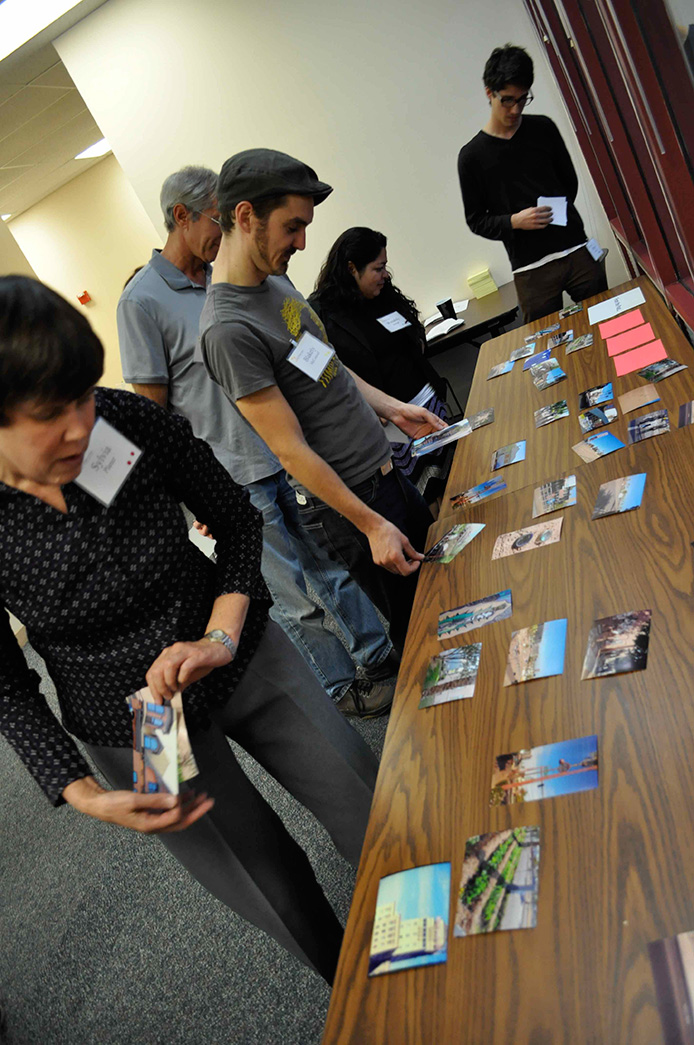 PAST Deliberation (Session 3_2)
PAST Deliberation (Session 3_2)
Participants then returned to their tables and shared with their group for 10 minutes why their images have persisted into the present (for better or worse). Then for the next 10 minutes participants discussed which three images are most likely to persist into the future (for better or worse) and WHY?
This discussion needed a lot of help to maintain the power dynamics among participants since the more confident folks were now fully comfortable in the group and very good at taking over. In addition, there were a lot of discrepancies and polarizations in the groups during this discussion. To manage this, it might be important to ask participants to try to lay out some of those disagreements as descriptions for what image or features of the image made it most likely to persist into the future.
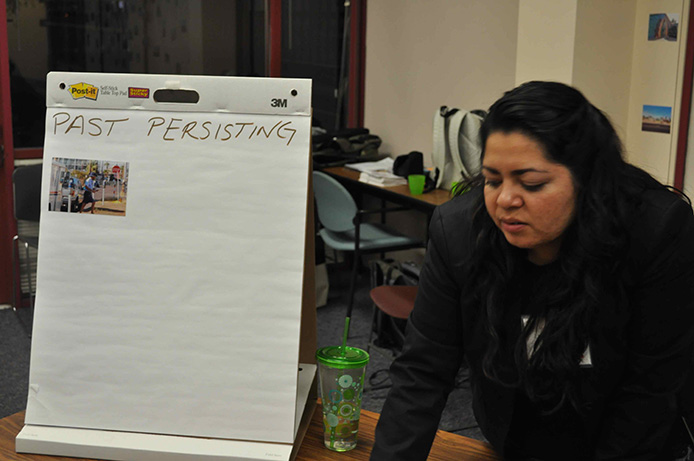 Past Persisting (Session 3_4)
Past Persisting (Session 3_4)
By the end of this session, participants must choose someone to explain in writing on a large post-it why the group chose the three images they chose and then each group will report out to the larger group. This gives the opportunity for the groups to see some of the similarities and differences in thinking. It also allows participants to find their views represented by others, when their own group may not have represented them well.
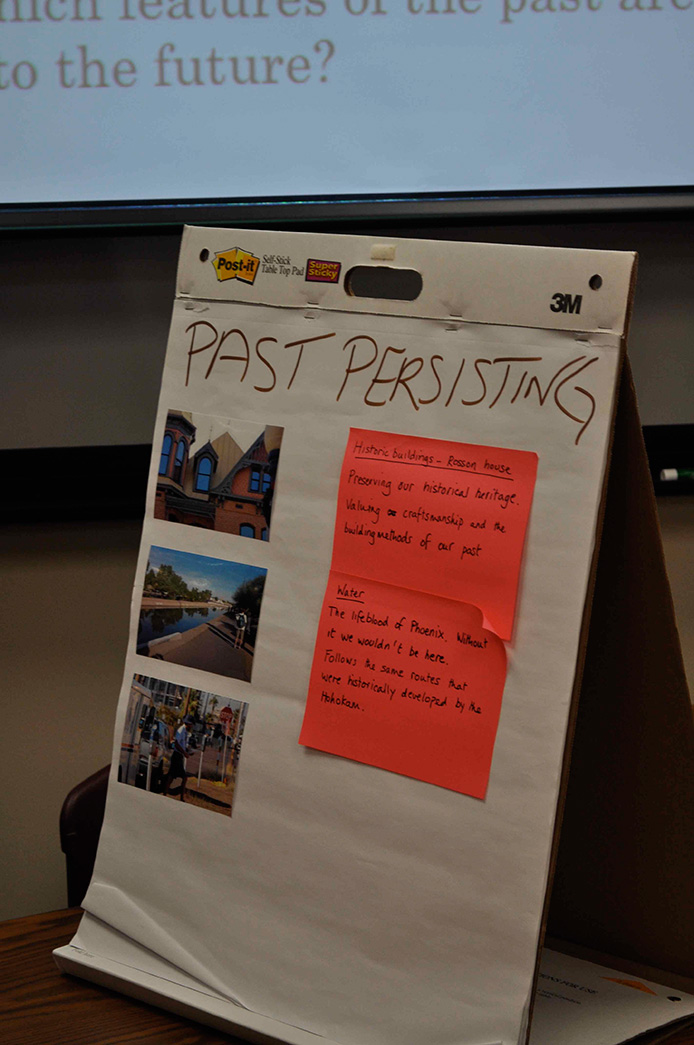 Flip Charts (Session 3_14)
Flip Charts (Session 3_14)
For the PRESENT Session, all of the copies of the present photos must be stuck to a wall. Then participants go to the wall and pick out, without removing them, two photos that best represent the present, both positive and negative aspects of it.
 PRESENT Images on wall (Session 3_6)
PRESENT Images on wall (Session 3_6)
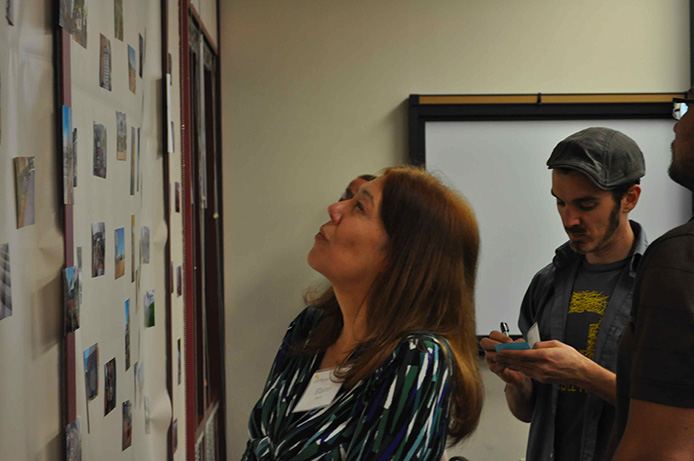 Choosing the Present (Session 3_5)
Choosing the Present (Session 3_5)
Then participants go back to their tables and write on stick notes, orange for positive, blue for negative, why those images best represent important characteristics of the present. After the participants finish writing their explanations, everyone should return to the wall and place their sticky note next to the coordinating picture.
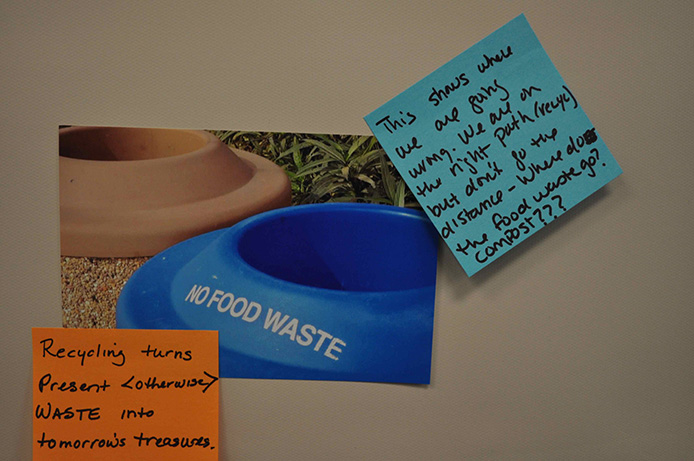 Characteristics of the PRESENT (Session 3_7)
Characteristics of the PRESENT (Session 3_7)
Then, dinner is served and while people are waiting for dinner, folks have the opportunity to look and read what others have written.
For the exhibition, we changed the color of the sticky notes, and allowed people to continue adding comments. The change of color let observers see which notes were added during the deliberative session and which notes were added later. This could also be done during the deliberative session. If participants want to comment on comments, ask them to use different colors to track the order of these comments. This allows participants a chance to think, individually, about some of the reasons and observations of others.
For the FUTURE session, we created a long time line from the present into the future on a large sheet of paper. We wrote 2015, 2020, 2030, 2040, 2050 along the X axis. From top to bottom (Y axis) we included a scale from desirable to undesirable. Everyone chooses 3 images from the Future collection. Then on a large sticky note they explain WHY those three images best represent the future of Phoenix. Then everyone comes to the board and explains each of their pictures to the entire group. They also must place their images on the spectra.
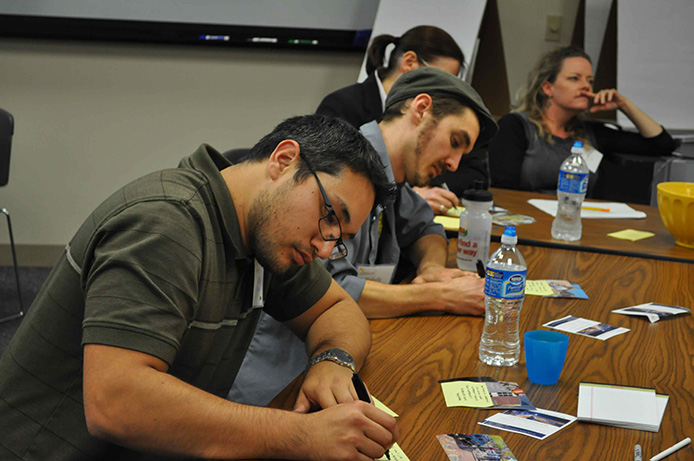 Explaining the Future (Session 3_9)
Explaining the Future (Session 3_9)
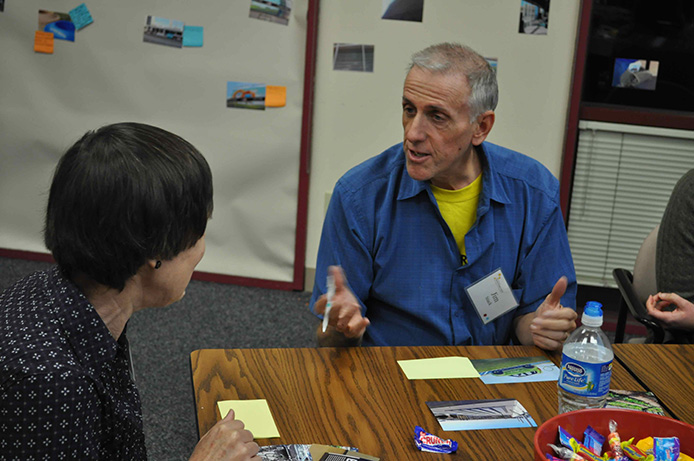 Dialogue about the Future (Session 3_8)
Dialogue about the Future (Session 3_8)
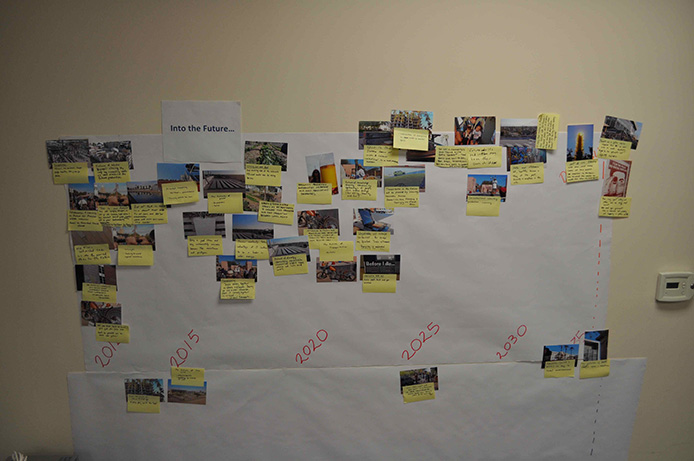 Into the Future (Session 3_11)
Into the Future (Session 3_11)
 (Session 3_12)
(Session 3_12)
Finally, we conducted a 40 minute synthesis session. As a group, for 10 minutes we addressed the following questions: Now we have explored the future: looking at this work, what can we say about desirable futures? What do you see? What is missing? What surprises you?
For 15 minutes, at each table we addressed the following questions: What role does technology play in reaching that desired future? What have we learned about the development of nanotechnology? What do you want from emerging technologies?
For 10 minutes, we reported back the high lights of the table discussions.
Finally, for the last 10 minutes we conducted a quick evaluation of the process with participants based on the ![]() session_iii_3_questions.ppt listed in the agenda.
session_iii_3_questions.ppt listed in the agenda.
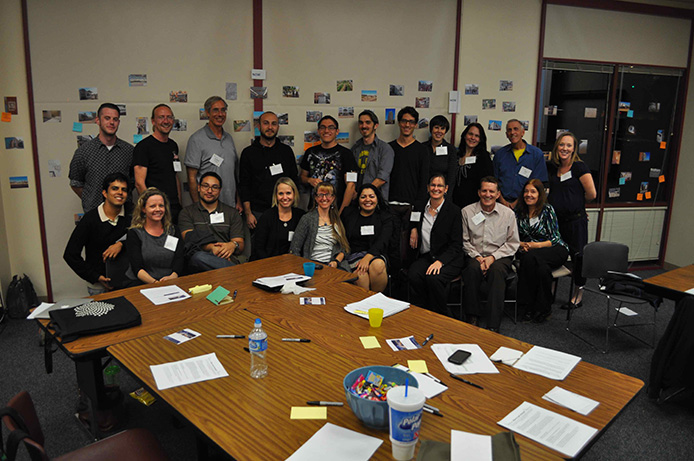 Big Family (Session 3_10)
Big Family (Session 3_10)
Brief Outline of Session III:
- 3:00 PM to 3:30 PM: Arrive to being set up. Note, setting up for Session III takes longer than for Session I because of the images.
- 4:45 PM to 5:00 PM: Check participants in and ask them to begin looking at images.
- 5:00 PM: Welcome
- 5:15 PM to 5:50 PM: Session I: PAST
- 5:50 PM to 6:15 PM: Session II: PRESENT and begin dinner
- 6:15 PM to 6:30 PM: Dinner
- 6:30 PM to 7:15 PM Session III: FUTURE
- 7:15 PM to 7:25 PM: Beginning of group synthesis. As a large group answer the following: Now we have explored the future: looking at this work, what can we say about desirable futures? What do you see? What is missing? What surprises you?
- 7:25 PM to 7:40 PM: At each table answer questions about the future of Phoenix: What role does technology play in reaching that desired future? What have we learned about the development of nanotechnology? What do you want from emerging technologies?
- 7:40 PM to 7:50 PM: Report to the group at large each table’s discussion. Record.
- 7:50 PM to 8:00 PM: Closing remarks and evaluation of tour discussion. Record
Here is the powerpoint from the April Training pertaining to Session III.


